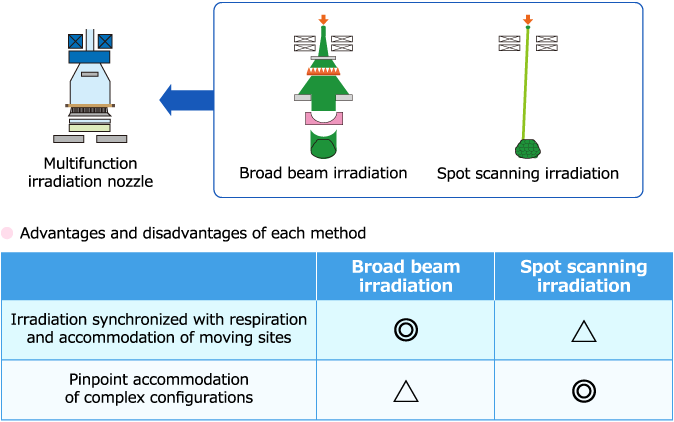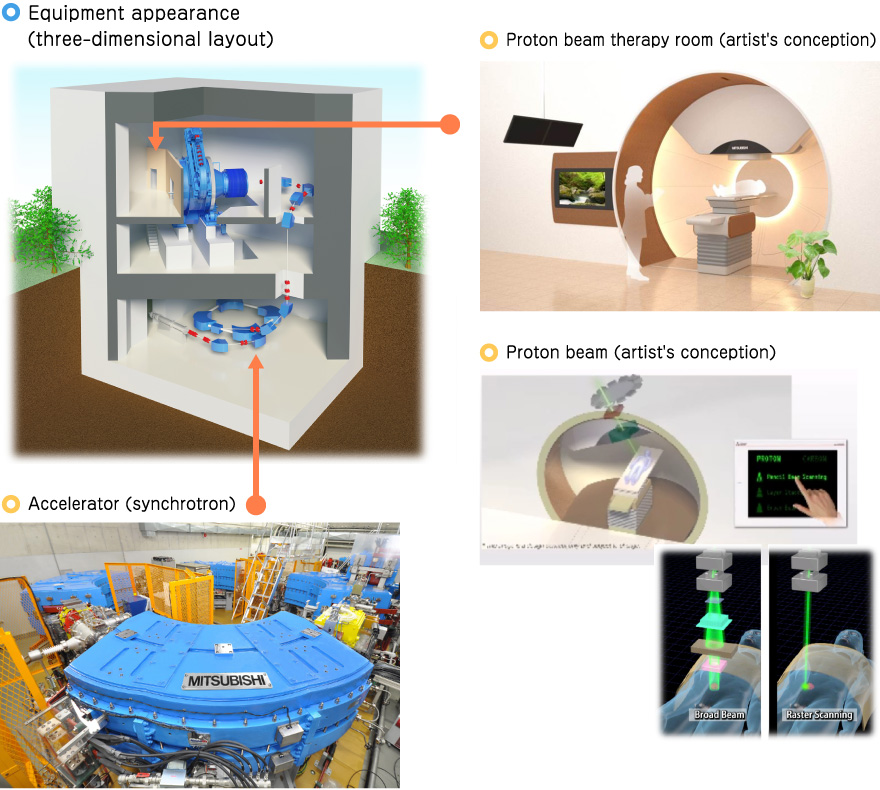Profile of the Center's Facilities
Facility Features
1A state-of-the-art proton beam therapy system that brings together leading-edge technologies
The proton beam therapy devices at the Center are the crystallization of state-of-the-art technology. For proton beam irradiation, a method called "broad beam irradiation" has conventionally been used. This is a method that performs irradiation using a bundle of proton beams shaped to match the lesion. In contrast to this, a method termed "spot scanning irradiation" has recently been developed. This is a method that visualizes the lesion as a mass of points and irradiating each point individually, tone at a time. Each is especially suited to a respective area, with broad beam irradiation being useful for lesions that move with respiration and also having the advantage of allowing treatment times to be shortened. Spot scanning irradiation, meanwhile, makes possible the ultimate in pinpoint irradiation, and demonstrates usefulness in such cases as lesions of complex shape and of organs in shallow locations for which high levels of irradiation is undesirable. Consequently, the determination of the utility each method is made according to such matters as the site, size, shape, and motility of the lesion. The Center has two treatment rooms, and both are designed to allow use of either technique, enabling treatment that gives full play to the advantages of both broad beam and spot scanning irradiation. This is also the first facility in Japan capable of switching button the two methods on a single device, and so in the future it will become possible to achieve treatment of greater precision through a combination of broad beam and spot scanning irradiation while the patient remains lying on the treatment table.

2Treatment in an open and spacious environment that faces a park and enjoys convenient access
The Center is located on Port Island, and can be reached in under 20 minutes from Sannomiya, the Kansai transportation hub. It is also close to the Shinkansen's Shin-Kobe Station and Kobe Airport, giving the location access of tremendous convenience. Proton beam therapy often involves outpatient commuting for several weeks, and this convenient access reduces the physical burden, and can also increase the possibility of being able to continue working while receive treatment. The Center faces Minami Park, which residents use as a place for recreation and relaxation, and patients can receive treatment in restful surroundings that are open and spacious.
3Advanced cancer treatment through alliance with Kobe Medical Cluster
As one link in the Kobe medical-industry initiative, Port Island has developed into one of Japan's largest medical clusters. This brings together a concentration of hospitals, research institutes, and companies with the aim of achieving medical care and medical science that is more advanced. The Center makes full use of proton beam therapy technologies cultivated at the Hyogo Ion Beam Medical Center to conduct outpatient-only treatment, but through alliance with adjacent medical institutions, we are making treatment activities and consultations associated with hospitalization, treatment in combination with chemotherapy, and surgical procedures such as marker insertion accomplishable simply and easily within walking distance, and are striving to practice comprehensive, high-quality medical care.
4Adjacent to Prefectural Kobe Children's Hospital and practicing comprehensive pediatric care
The Center was established as a facility that emphasizes treatment of pediatric cancer patients. One of the two treatment rooms is exclusively for pediatric use. The Center is adjacent to Prefectural Kobe Children's Hospital and is designed for access to and from the hospital via a connecting corridor. Pediatric patients sometimes experience reduced immunity due to chemotherapy in the hospital ward, and so the building was designed for isolation from contact with adults. What is more, we have adopted a system for close collaboration with specialist pediatric staff in the Children's Hospital, and pediatric patients are able to receive proton beam therapy at the Center in a smooth manner while ward management is conducted at the Children's Hospital. The Center not only employs an interior design and amenities that take into account the sentiments of children and enable care to be received with peace of mind, but also offers a fully equipped nursing room. Anesthesiologists who have extensive experience in anesthesizing pediatric patients are also in full-time service at the Center. At many other facilities, treatment while sedated is possible only when no surgery is scheduled, but because the Center is staffed with full-time anesthesiologists for proton beam therapy, treatment can be given to multiple patients under safe and efficient sedation every day. These endeavors are earning close attention as the first facility of its kind in Japan. The treatment equipment also implements a quiet design to allow use with sedated pediatric patients.
The Proton Beam Therapy System

The equipment required for proton beam therapy, broadly speaking comprises an accelerator system to accelerate the protons, a delivery system to transport the accelerated proton beam to the treatment room, an irradiation system to irradiate the patient with the proton beam, and a control system to control the degree of acceleration of the protons and the depth of irradiation.
The treatment system accelerates protons to about 70% the speed of light using the accelerator, then guides them into the irradiation chamber and irradiates the affected area. Accelerating the protons creates a proton beam of high kinetic energy to irradiate lesions deep in the body.







